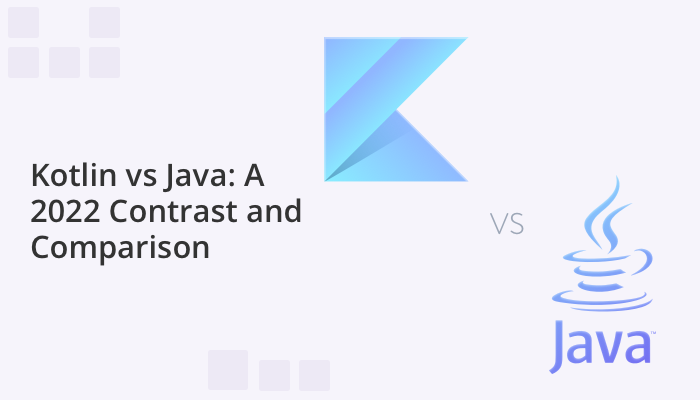
Kotlin or Java – if you are asking this question it means that you are most likely an Android developer or going to become one. It is in the context of Android app development that these two programming languages are compared the most often.
Let’s make our own “Kotlin vs Java” comparison to highlight the strengths of both languages and see which is a better choice for an Android app development project.
What is Java?
Between Kotlin and Java, Java has been around much longer – since 1995, when it was first created by Sun Microsystems. It is an object-oriented programming language that can be used on most devices and operating systems. Java is one of the most popular programming languages valued for its multi-platform usability.
Java is also the native language of Android. It is used the most frequently in native mobile apps written for the Android platform.
What is Kotlin?
Compared to Java, Kotlin is much younger – its first release was only in 2016. Kotlin is often referred to as “inspired by Java” and it’s true to say that it’s similar to Java, but it has a lot of syntactic sugar and more simple syntaxis which saves developers time and money when writing code. It is an open-source language combining object-oriented and functional programming features and can run on the Java Virtual Machine.
Kotlin is another native Android language used in many apps written for that platform.
Kotlin vs Java – which is better for native Android app development?
If you are choosing between Kotlin and Java as the programming language to learn and to use in developing native Android apps, we are going to help you by highlighting the most significant differences between the two languages.
Syntax concision
Between Kotlin and Java, Kotlin is much more concise and requires significantly fewer lines of code to achieve the same results as Java. At the same time, such brevity does not affect the readability of Kotlin’s code syntax. As a result, Kotlin may be a better choice for new projects, as the resulting volume of code will be shorter and thus easier to maintain.
By contrast, Java is less concise as it requires developers to describe all cases in a particular task. Thus coding can take more time. However, Java advocates point out that Java syntax is straightforward to learn, write, and maintain, and that the code is easily debuggable.
This may be one of the key differences between Kotlin and Java which greatly affects their performance. Java is an object-oriented language, while Kotlin combines object-oriented and functional programming. It allows computations based on mathematical functions, such as higher-order functions and lambda expressions. In Kotlin, you have more than one way to operate mathematical functions.
Java introduced some functional programming, specifically, lambda expressions, only in 2014.
Extension functions
With Kotlin, developers can add new functions to an existing class simply by adding the name of the class as a prefix to the name of the function. This way, there is no need to inherit from the parent class.
Java, on the other hand, does not offer this possibility without additional libraries. If you need to extend the functionality of a class, you need to create another class that will inherit the functionality from the class to be extended. Some developers argue that this method is not as fast and clear as the one that Kotlin supports. Although this is a point of debate.
Null safety
Java allows attributing null values to variables, which, under certain conditions, result in NullPointerExceptions. This means that Java developers may need to write more code to handle these exceptions.
In Kotlin, null safety is inherent, which spares developers from creating workarounds to get rid of null exceptions. The null safety is another factor contributing to the conciseness of Kotlin apps.
Concurrency
In an app running in the Android operating system, a long, complex task may block the main thread. As a result, the entire app may produce ANR error or crash in some cases. To prevent such situations, programming languages support concurrency allowing more than one job to be performed simultaneously.
In Java, concurrency is achieved through threads. Multiple threads can be created to run in the background to allow the handling of lengthy tasks. However, the creation of a background thread is a complex job in itself which is also prone to errors and requires a lot of knowledge about how to work with threads.
Kotlin handles concurrency through the support of so-called coroutines. This approach allows suspending and resuming code execution, thus creating non-blocking asynchronous code. Coroutines allow having a small number of threads in which several tasks can run at the same time.
Kotlin vs Java: which to learn?
From our Kotlin vs Java comparison, it seems that Kotlin may be a bit easier and cleaner than Java. It produces more lightweight applications that perform well while requiring less code and, therefore, a shorter time to create. Moreover, Kotlin is the official language for Android.
This being said, Java has been around longer and has evolved into a multi-platform language with robust coding options. Its developer community is also much larger than that of Kotlin which makes peer support more available and there are many older projects written in Java.
Within the context of Android development, Kotlin may be a slightly better choice than Java. Besides, if you are considering switching from Java to Kotlin, the transition may be rather easy, as familiarity with Java gives a solid foundation for learning Kotlin, whereas it’s much harder in the opposite direction.
One more thing, though – in creating mobile Android apps, a good practice is to use APIs and SDKs specially written for the platform and the particular language. Using SDKs allows integrating pre-built components that have been tried and tested to work in a particular environment. Instead of writing the entire code from scratch, choose a Java or Kotlin SDK to reuse its features in your app. This way, you can devote more time to creating your core functionality.
For example, if you are building an Android app that needs a communication feature – and today, most customer-serving apps do – check out the QuickBlox Android SDK which can be used with both Java and Kotlin. The SDK will help you integrate a complete chat app into your product creating great experiences for your users and saving your team’s time and resources.








